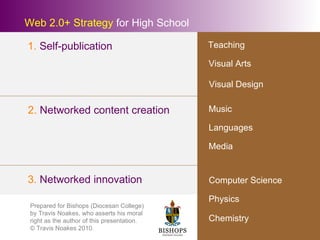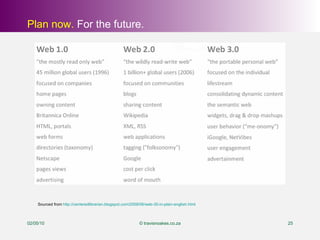Web 2.0+ Strategy for High School
- 1. Web 2.0+ Strategy for High School Visual Arts Languages Music Visual Design Physics 2. Networked content creation 3. Networked innovation 1. Self-publication Computer Science Chemistry Media Teaching Prepared for Bishops (Diocesan College) by Travis Noakes, who asserts his moral right as the author of this presentation. © Travis Noakes 2010.
- 2. It’s unofficial. Your High School is on social media. 02/05/10 © travisnoakes.co.za Oh, dear. What other online publications is our school on?
- 3. It’s on Wikipedia. More N.B. than your official site?
- 4. It is being blogged about. Blogging… or bogging? Mmm. What are they writing about my school ?
- 5. It has Facebook groups. Good face? Does our school fit in here at all?
- 6. Professional associations are formed from it. Pros & Cons?
- 7. Its has been tagged. What’s your folksonomy like?
- 8. Photos and videos will be shared. Simply the best?
- 9. Your aspirant creatives, journalists, programmers, scientists and gamers may use it, too. And you?
- 10. Why? 3 trends . Cheaper ICT Faster bandwidth Low storage costs
- 11. Cheaper ICT means growing accessibility. Computer access will soon be broader than the computer labs and laptops at school: Growth in mobile phone, netbook and tablet users. Increase in the number of networked gaming platforms, televisions, phones, fridges, etc.
- 12. Storage is mostly free in the attention economy.
- 13. Faster bandwidth ends the text-dominant web. The international bandwidth available to sub-Saharan Africa will increase 120 times from 80 Gigabits per second (2008) to 10 Terabits by the end of 2011 {due to six new cables and an upgrade to SAT3}.
- 14. Abundance culture is here. Can you shift your mindset? Table used in Chris Anderson’s “Free”, 2009
- 15. Web 1.0 Web 2.0 What the change means for education Licensed or purchased > Free = Easily adoptable Expert publishers > Easy-to-publish = All have a voice Isolated > Collaborative = Co-create knowledge Unrated content > Rateable = Rate and share reviews Single source > Mash-ups = Easily contrast information Proprietary code > Open-source = Can be peer-reviewed Copyrighted content > Shared content = Customise publications Directory (taxonomy) > Folksonomy (tagging) = Personal meanings Advertising > Word-of-mouth = Reputation management Push content > Pull content = What interests me Passive consumer > Interactive prosumer = Value can be co-created The passive consumer’s mind shifts to an active prosumer’s. Based on a table from the book Web 2.0: New Tools, New Schools
- 16. The youth have shifted theirs: Generation C(ontent) 2005 Pew Internet & American Life Project survey Teen Content Creators and Consumers revealed that over half of all teens with access to broadband were creating content for it. December 2007’s sequel report Teens and Social Media confirmed that teen content creation is rapidly becoming more prevalent than first indicated.
- 17. “ C” issues! privacy, security, copyright, feedback EQ, … Does your school inspire students to be digitally literate? Understand and respect copyright (where relevant) Understand the difference between public and private voice (if digital, probably not private) Respect others online with emotionally intelligent ratings and feedback (cyber-bullying policy?) Know how to protect their safety (safeguard contact details) Identify spam. Spot scam. Kill viruses. Be effective prosumers.
- 18. Turn the “Out Of Control” challenge… 02/05/10 © travisnoakes.co.za
- 19. … into “Blooming Opportunities”! 02/05/10 © travisnoakes.co.za
- 20. Define your principles. Consultative, open project or projects Get consultants to advise on best practice Augment work that’s been done Do strategic planning Do internal and external research Low-cost Focus on the low-hanging fruit Avoid duplication of effort Take advantage of the freemium economy Justifiable resourcing (community manager?) Minimal resourcing (i.e. part-time community manager) Below market-related cost for services High-return Charitable donations (micro-payments), low-key online advertising Brand equity (reputation management) Better educational experience for teachers and pupils Open to new ideas and approaches (Do It Wrong, Quickly) High standards (world-class example by an internationally-leading school) Outcomes-based (build, maintain and grow conversations) Sustainable (create an ongoing relationship) Set an example for other schools to follow
- 21. Unite around the big opportunity. Define the scope. A world-class example of how a high school uses social media. An opportunity to begin addressing: the participatory gap the relevance gap the digital divide
- 22. Consult. Strategise. Prioritise. Act now. Do you hire a social media manager? Does each department include a digital literacy curriculum from grade 10? Are online portfolios important? Should you share more Intellectual Property (IP)? Can you manage “exit, voice and loyalty” better? Should you create reciprocal links to other brand ambassadors online? Should you raise your profile on the Department of Education’s website? Do teachers need training and incentives for informal use?
- 23. Curriculum change. How could each department benefit? Online gaming Citizen journalism Software development Scientific collaboration HIGH COLLABORATION Social networking Social bookmarking Product recommendation Networked content creation Networked innovation Blogging Sharing videos, images and music Rating others’ work Providing reviews Self-publication MEDIUM COLLABORATION LOW COLLABORATION Visual Arts Writing Music Visual Design Physics Computer Science Chemistry Photography Teaching Video Creators - Critics - Collectors - Joiners - Spectators – Inactives
- 24. Transcend silofication. Make your structures fit for Web 2.0 + The web; that’s the IT department’s baby! Don’t bother me… If it’s media, it must be for artists, right? This isn’t what teaching’s really about, is it? What’s the laptop committee for, then?
- 25. Plan now. For the future. 02/05/10 © travisnoakes.co.za Sourced from http://centeredlibrarian.blogspot.com/2009/06/web-30-in-plain-english.html
- 26. Thanks for your time ! Stock imagery sourced from www.dreamstime.com Design by Travis Noakes
Editor's Notes
- Thanks for being here.
- Whether your High School wants to participate in social media, or not, it already is. - So, who knows what is being said about Bishops in social media? - Is someone responsible for understanding and addressing what they are saying?
- Wikipedia is the world’s free encyclopedia and is consistently ranked as one of the ten most popular websites in the world: Question Do more internet visitors see the Wikipedia entry on your school than its official website? Is this content a fair reflection on your school? Should your school improve this content?
- Does your school understand who is writing about it? Can your school respond pro-actively to blogs? Does your school “give back” by supporting credible OD blogs with reciprocal links? (i.e. www.markshuttleworth.com, www.ideate.co.za, etc.)
- What is the use of an official Facebook Group? What criteria are used to use one social media platform versus another?
- - What use is LinkedIn? - Should Bishops monitor its own group(s) on it?
- Is it important to make the best photographs and videos publically available? How important is making it easy for third parties to improve and grow the school’s online presence and brand? Is our fear of online media’s potential problems too great and undermining the potential good that media can do for the school.
- What does your school know about its students media preferences? How can your school benefit from exposure on crowdsourced sites? What are the online opportunities that your best and brightest students could benefit from being exposed to?
- - What is your school doing to make these trends your friends?
- So, does your Laptop Committee and Computer Labs need new names?
- How can your school benefit from the rise of cloud computing? How can your students, teachers and administrators benefit from free storage?
- - How will your school compete in the new, media-rich environment?
- - Is your school’s culture ready to accommodate the Web? - Read Chris Anderson’s article on “ Tech Is Too Cheap to Meter: It's Time to Manage for Abundance, Not Scarcity” at http://www.wired.com/techbiz/it/magazine/17-07/mf_freer?currentPage=2
- The growth in unofficial, informal content is growing, led by two major trends. The first is the affordances of web 2.0 leading to prosumers replacing consumers; an active audience emerging online with more influence than the passive consumer of the past. - What is your school doing to teach its students, teachers and administrators to be good prosumers?
- - Have your school’s policies adapted to accommodate the rise of generation Content?
- - Does your school provide a sound contextual framework for media use?
- At the very least, web 2.0 can be proactively used to raise Bishops’ visibility. At best, it can build on the ICT innovation at Bishops and be used to augment teacher pedagogy, student learning experience, motivation and performance.
- - In June 2009, Bishop’s principal and vice-principal agreed to these principles for a social media project.
- Is this exectuive goal shared in your school? What are the low hanging fruit for your school? - Is it important for your school to address the participatory and relevance gaps and digital divide? The ‘relevance gap’ is the difference between what students learn and the knowledge they must apply in the future, particularly at work, but increasingly in leisure-time, too. The effects of the difference between home and school participation in social media has been termed the ‘participatory gap ’ . This identifies the difference between a pupil’s formal educational experience in school versus their informal experience of technology and popular culture outside school. The digital divide is defined as disparity in access to Information and Communication Technologies (ICTS), which may result from differences in class, race, age, culture, geography or other factors (Kroukamp, 2005).
- - What is the opportunity cost of doing nothing?
- - Is your school focusing on the negatives to the detriment of the positives?
- - Can your school’s structure facilitate social media?
- Digital Inspiration explains the difference between web iterations in a clear and concise manner. There are six video presentations that lay it all out in simple and easily understood language. From the site: Web 1.0 - That Geocities & Hotmail era was all about read-only content and static HTML websites. People preferred navigating the web through link directories of Yahoo! and dmoz. Web 2.0 - This is about user-generated content and the read-write web. People are consuming as well as contributing information through blogs or sites like Flickr, YouTube, Digg, etc. The line dividing a consumer and content publisher is increasingly getting blurred in the Web 2.0 era. Web 3.0 - This will be about semantic web (or the meaning of data), personalization (e.g. iGoogle), intelligent search and behavioral advertising among other things.Found at iLibrarian

























